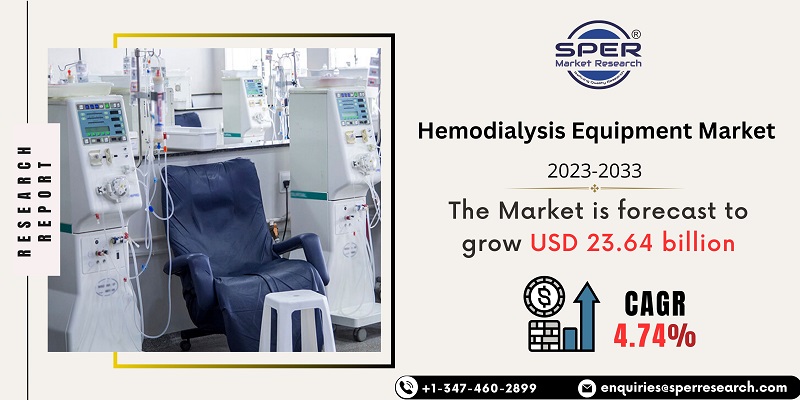
Hemodialysis Equipment Market Growth, Size, Trends, Revenue, Share, Challenges and Future Scope
Hemodialysis Equipment Market Size- By Product, By End User- Regional Outlook, Competitive Strategies and Segment Forecast to 2033
| Published: Jul-2023 | Report ID: MEDE2318 | Pages: 1 - 234 | Formats*: |
| Category : Medical Devices | |||
- Technological Advancements: Advancements in hemodialysis technology have led to improved efficiency, safety, and patient comfort. Innovative dialysis machines, hemodialyzers, and associated equipment with features like online monitoring, automated processes, and improved biocompatibility contribute to market growth.
- Growing Aging Population: The global aging population is a significant contributor to the growth of the hemodialysis equipment market. Elderly individuals are more susceptible to kidney-related diseases, including chronic kidney disease (CKD) and ESRD.


| Report Metric | Details |
| Market size available for years | 2019-2033 |
| Base year considered | 2022 |
| Forecast period | 2023-2033 |
| Segments covered | By Product, By End-User |
| Regions covered | Asia-Pacific, Europe, Middle East and Africa, North America, Latin America |
| Companies Covered | Asahi Kasei Corporation, Baxter International Inc, Braun Melsungen AG, Fresenius Kabi AG, JMS Co., Ltd., Nikkiso Co., Ltd., NIPRO CORPORATION, TORAY INDUSTRIES, INC., Others. |
- Dialysis Technicians and Nurses
- Government and Regulatory Bodies
- Hospitals and Healthcare Facilities
- Medical Device Manufacturers and Suppliers
- Nephrologists and Renal Care Specialists
- Patients and Patient Advocacy Groups
- Purchasing and Procurement Managers
- Others
| By Product: |
|
| By End-User: |
|
- Global Hemodialysis Equipment Market Size (FY’2023-FY’2033)
- Overview of Global Hemodialysis Equipment Market
- Segmentation of Global Hemodialysis Equipment Market By Product (Hemodialysis Machines, Hemodialysis Consumables)
- Segmentation of Global Hemodialysis Equipment Market By End-User (Hospitals, Independent Dialysis Centres, Home Dialysis)
- Statistical Snap of Global Hemodialysis Equipment Market
- Expansion Analysis of Global Hemodialysis Equipment Market Problems and Obstacles in Global Hemodialysis Equipment Market
- Competitive Landscape in the Global Hemodialysis Equipment Market
- Impact of COVID-19 and Demonetization on Global Hemodialysis Equipment Market
- Details on Current Investment in Global Hemodialysis Equipment Market
- Competitive Analysis of Global Hemodialysis Equipment Market
- Prominent Players in the Global Hemodialysis Equipment Market
- SWOT Analysis of Global Hemodialysis Equipment Market
- Global Hemodialysis Equipment Market Future Outlook and Projections (FY’2023-FY’2033)
- Recommendations from Analyst
1.1. Scope of the report1.2. Market segment analysis
2.1. Research data source2.1.1. Secondary Data2.1.2. Primary Data2.1.3. SPER’s internal database2.1.4. Premium insight from KOL’s2.2. Market size estimation2.2.1. Top-down and Bottom-up approach2.3. Data triangulation
4.1. Driver, Restraint, Opportunity and Challenges analysis4.1.1. Drivers4.1.2. Restraints4.1.3. Opportunities4.1.4. Challenges4.2. COVID-19 Impacts of the Global Hemodialysis Equipment Market
5.1. SWOT Analysis5.1.1. Strengths5.1.2. Weaknesses5.1.3. Opportunities5.1.4. Threats5.2. PESTEL Analysis5.2.1. Political Landscape5.2.2. Economic Landscape5.2.3. Social Landscape5.2.4. Technological Landscape5.2.5. Environmental Landscape5.2.6. Legal Landscape5.3. PORTER’s Five Forces5.3.1. Bargaining power of suppliers5.3.2. Bargaining power of buyers5.3.3. Threat of Substitute5.3.4. Threat of new entrant5.3.5. Competitive rivalry5.4. Heat Map Analysis
6.1. Global Hemodialysis Equipment Market Manufacturing Base Distribution, Sales Area, Product Type6.2. Mergers & Acquisitions, Partnerships, Product Launch, and Collaboration in Global Hemodialysis Equipment Market
7.1. Global Hemodialysis Equipment Market Value Share and Forecast, By Product, 2023-20337.2. Hemodialysis Machines7.3. Hemodialysis Consumables
8.1. Global Hemodialysis Equipment Market Value Share and Forecast, By End-User, 2023-20338.2. Hospitals8.3. Independent Dialysis Centres8.4. Home Dialysis
9.1. Global Hemodialysis Equipment Market Size and Market Share
10.1. Global Hemodialysis Equipment Market Size and Market Share By Product (2019-2026)10.2. Global Hemodialysis Equipment Market Size and Market Share By Product (2027-2033)
11.1. Global Hemodialysis Equipment Market Size and Market Share By End-User (2019-2026)11.2. Global Hemodialysis Equipment Market Size and Market Share By End-User (2027-2033)
12.1. Global Hemodialysis Equipment Market Size and Market Share By Region (2019-2026)12.2. Global Hemodialysis Equipment Market Size and Market Share By Region (2027-2033)12.3. Asia-Pacific12.3.1. Australia12.3.2. China12.3.3. India12.3.4. Japan12.3.5. South Korea12.3.6. Rest of Asia-Pacific12.4. Europe12.4.1. France12.4.2. Germany12.4.3. Italy12.4.4. Spain12.4.5. United Kingdom12.4.6. Rest of Europe12.5. Middle East and Africa12.5.1. Kingdom of Saudi Arabia12.5.2. United Arab Emirates12.5.3. Rest of Middle East & Africa12.6. North America12.6.1. Canada12.6.2. Mexico12.6.3. United States12.7. Latin America12.7.1. Argentina12.7.2. Brazil12.7.3. Rest of Latin America
13.1. Asahi Kasei Corporation13.1.1. Company details13.1.2. Financial outlook13.1.3. Product summary13.1.4. Recent developments13.2. Baxter International Inc13.2.1. Company details13.2.2. Financial outlook13.2.3. Product summary13.2.4. Recent developments13.3. Braun Melsungen AG13.3.1. Company details13.3.2. Financial outlook13.3.3. Product summary13.3.4. Recent developments13.4. Fresenius Kabi AG13.4.1. Company details13.4.2. Financial outlook13.4.3. Product summary13.4.4. Recent developments13.5. JMS Co., Ltd.13.5.1. Company details13.5.2. Financial outlook13.5.3. Product summary13.5.4. Recent developments13.6. Nikkiso Co., Ltd.13.6.1. Company details13.6.2. Financial outlook13.6.3. Product summary13.6.4. Recent developments13.7. NIPRO CORPORATION13.7.1. Company details13.7.2. Financial outlook13.7.3. Product summary13.7.4. Recent developments13.8. TORAY INDUSTRIES, INC.13.8.1. Company details13.8.2. Financial outlook13.8.3. Product summary13.8.4. Recent developments13.9. Others
SPER Market Research’s methodology uses great emphasis on primary research to ensure that the market intelligence insights are up to date, reliable and accurate. Primary interviews are done with players involved in each phase of a supply chain to analyze the market forecasting. The secondary research method is used to help you fully understand how the future markets and the spending patterns look likes.
The report is based on in-depth qualitative and quantitative analysis of the Product Market. The quantitative analysis involves the application of various projection and sampling techniques. The qualitative analysis involves primary interviews, surveys, and vendor briefings. The data gathered as a result of these processes are validated through experts opinion. Our research methodology entails an ideal mixture of primary and secondary initiatives.



Frequently Asked Questions About This Report
PLACE AN ORDER
Year End Discount
Sample Report
Pre-Purchase Inquiry
NEED CUSTOMIZATION?
Request CustomizationCALL OR EMAIL US
100% Secure Payment






Related Reports
Our Global Clients
Our data-driven insights have influenced the strategy of 200+ reputed companies across the globe.




















